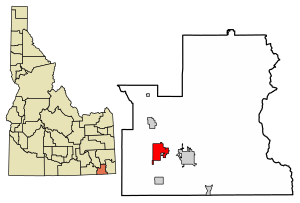Dayton, Idaho facts for kids
Quick facts for kids
Dayton, Idaho
|
|
|---|---|

Location of Dayton in Franklin County, Idaho.
|
|
| Country | United States |
| State | Idaho |
| County | Franklin |
| Area | |
| • Total | 6.72 sq mi (17.39 km2) |
| • Land | 6.67 sq mi (17.29 km2) |
| • Water | 0.04 sq mi (0.11 km2) |
| Elevation | 4,751 ft (1,448 m) |
| Population
(2020)
|
|
| • Total | 510 |
| • Density | 74.02/sq mi (28.58/km2) |
| Time zone | UTC-7 (Mountain (MST)) |
| • Summer (DST) | UTC-6 (MDT) |
| ZIP code |
83232
|
| Area code(s) | 208 |
| FIPS code | 16-20710 |
| GNIS feature ID | 2410298 |
Dayton is a city in Franklin County, Idaho, United States. In 2020, 510 people lived there. It is part of the larger Logan, Utah-Idaho area. This area is known as a Metropolitan Statistical Area.
Contents
History of Dayton
In 1867, Joseph Chadwick and his family moved to this area. They built a log cabin near Five Mile Creek. Joseph also had a small store in his cabin. This store helped the few settlers and traders. Other families soon joined them. These included Peter Poole, Robert Taylor, and Stephen Callan.
The area had a few different names over time. It was first called Franklin Meadows. Then it became Five Mile Creek. Later, it was known as Chadville, and then Card in 1890. In 1906, William B. Preston gave it the name Dayton. Fred Jenson was an early leader of the Mormon community there. By 1930, Dayton had 271 residents.
Geography of Dayton
Dayton is located on the west side of Cache Valley. It sits along Five Mile Creek. The Bannock Mountains are also nearby.
The city covers about 6.56 square miles (17.0 square kilometers). Most of this area is land. Only a small part, about 0.04 square miles (0.11 square kilometers), is water.
Dayton's Climate
Dayton has a type of weather called a humid continental climate. This means the city experiences big changes in temperature throughout the year. Summers are usually warm to hot. They can sometimes be humid. Winters are cold, and can sometimes be very cold.
Dayton's Population
| Historical population | |||
|---|---|---|---|
| Census | Pop. | %± | |
| 1920 | 225 | — | |
| 1930 | 271 | 20.4% | |
| 1940 | 364 | 34.3% | |
| 1950 | 287 | −21.2% | |
| 1960 | 212 | −26.1% | |
| 1970 | 198 | −6.6% | |
| 1980 | 368 | 85.9% | |
| 1990 | 357 | −3.0% | |
| 2000 | 444 | 24.4% | |
| 2010 | 463 | 4.3% | |
| 2020 | 510 | 10.2% | |
| U.S. Decennial Census | |||
Dayton's Population in 2010
In 2010, Dayton had 463 people. There were 134 households. A household is a group of people living in one home. Most of the people (93.1%) were White. About 4.3% were from other races. Another 2.6% were from two or more races. About 6.5% of the population was Hispanic or Latino.
Many households had children. About 48.5% of homes had kids under 18. Most households (76.9%) were married couples. The average household had 3.46 people. The average family had 3.72 people.
The average age in Dayton was 31.1 years. About 32.8% of residents were under 18. About 13.4% were 65 or older. The city had slightly more males (50.8%) than females (49.2%).
See also
 In Spanish: Dayton (Idaho) para niños
In Spanish: Dayton (Idaho) para niños

